


This week’s post was written by Dr Ian Street (@IHStreet), the Resources Editor at AoB Blog. He is also a science writer and plant scientist. His science blog is The Quiet Branches.
On 18th May 2017, plant scientists from all over the world celebrated “International Fascination of Plants Day”. This year, plant enthusiasts could follow events around the world – thanks to social media and live-streaming. Scientists shared live broadcasts about the science they do, the facilities where they work, models from history, about engaging students with plants, and more. Botany Live, organized by the AoB Blog, was an experiment in science engagement supported by the Society for Experimental Biology, The Annals of Botany Company, and Plantae. Overall, thousands tuned in to 31 planned events registered with Botany Live.
Using Periscope and Facebook Live, some reported from dedicated events planned around Plant Day. Others talked directly to the camera and their virtual audience about plants, plant science, and communicating plant science.
The Arabidopsis Biological Resource Center (ABRC) at Ohio State University showed off the facilities and robots they use to maintain both gene stocks and seed stocks. These facilities and resources, which provide essential support for plant research, are often only known within the plant science community. Even there, how they operate on a day-to-day basis remains a mystery to many. Botany Live allowed us to take a peek at the support structures that make international plant science possible. The ABRC videos also showed how plant science is using cutting edge technology with robots to automate seed sorting and gene stocks.
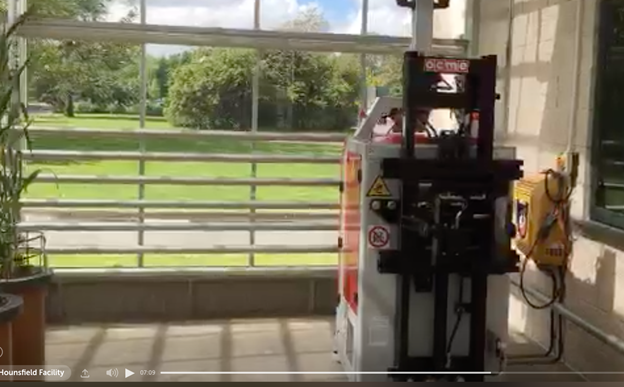
Frame from the Hounsfield Facility Botany Live Broadcast, showing the glass house and the robot that carries individual plants to be scanned.
A tour of the Hounsfield X-ray Facility (@UoNHounsfield) demonstrated the high-tech nature of modern plant science too. The staging the Hounsfield video was clever, as the scientists there clearly set up marks they had to hit to be on camera at certain times demonstrating the three sizes of scanner at the facility. Their live-stream ended with Malcolm Bennett in the glass house talking about the importance of exploring root traits, a big part of what they track at Hounsfield with robots and 3D X-ray tomography.
The National Institute of Agricultural Botany (NIAB) wheat transformation facility broadcast brought us cutting-edge biology directly from the field. Alison Bentley (@AlisonRBentley) guiding us around the facility, where scientists develop and field test new varieties of wheat, followed by a look around their glasshouses. Geraint Parry (@GARNetweets) then interviewed several NIAB conference attendees. A specialized facility for wheat transformation (making transgenic wheat) is, like the ABRC and Hounsfield, a resource of a special capacity to do something technical that not all individual labs can develop.

An infected plant in background and flower in the foreground from Monica Lewandowski’s Botany Live Broadcast.
Another outdoor tour of a garden in California was given by Monica Lewandowski. She highlighted the diversity of plants grown in the state’s central valley. She also spoke about some of the challenges that plants face, and why we need plant scientists to study them. It showed the simplicity possible with Periscope broadcasts, as her session focused on just her with planned talking points, a walking path, and her voice-over.
Alun Salt of the AoB Blog brought us some short broadcasts from Kew Gardens. He gave a brief tour of the Wollemi pine, an ancient lineage known only from fossils until 1994. He also gave a quick overview of the garden’s carnivorous plants, including the coolest plant in the world, Darlingtonia californica.
Several Botany Live recordings involved school students. Alistair Culham and Dr M (@drmgoeswild) broadcast a video with students about what they’d done earlier, counting plants and observing them. Many of the students were surprised to learn where pineapples come from: not from a tree, but a bush yielding a single pineapple a year. The Gramene Database (@GrameneDatabase) broadcast a talk with students about plants’ superpowers such as resurrection plants, which can lose 95% of their water and seemingly come back to life upon rehydration. Maria Papanatsiou (@m_papanatsiou) from the University of Glasgow broadcast Plant Day activities engaging students, and many of the videos can be found on the social wall of tweets made for Botany Live.
The most popular Plant Day broadcast was from the Manchester Museum, featuring botany curators Rachel Webster (Manchester) and Donna Young (Liverpool) talking about Brendel’s Plant Models collections from Manchester and the Liverpool World Museum. They’re remarkable models of plants, made of paper mache amongst other materials, created in 1880-1920 by a father/son team in Germany. They were designed to teach plant anatomy and many are incredibly intricate, with some even being able to be taken apart to show specific parts of a flower.

Brendel Plant Model Nr. 10, Pisum Sativum: Accreditation: By David Ludwig (own work at Botanical Museum in Greifswald) Image credit: CC BY-SA 3.0, via Wikimedia Commons.
Botany Live broadcasts came from all over the world, and the event can grow in the years to come. The format of live streaming is flexible, with elaborate or simple setups possible. Most broadcasts were under ten minutes, but some lasted almost an hour, and of course, they can be done nearly anytime and anywhere with a good data connection.
This first year of Botany Live was an experiment. With thousands of people reached (and likely more, as many of the videos are still available), it was a success and a boost to the Plant Day events already taking place, extending their reach online. Given the success the Manchester Museum had with their broadcast, more institutions being directly involved will help promote the live broadcasts and engage even more people in the fascinating world of plants.
Further reading:
GARNet newsletter also covered Botany Live in its May 2017 issue (pdf)
Celebrate Fascination of Plants Day (May 18th 2017) with an exciting new science communication project!
Botany Live is asking scientists, educators, science communicators and plant fans from around the world to live-stream their fascination with plants, sharing experiments, botanic garden explorations, tours of a lab or herbarium, Fascination of Plants Day events, interviews, discussions and more!
The aim is to spark an interest in new audiences, reaching people who might not otherwise engage with Fascination of Plants Day.
Get involved by emailing webmaster@aobblog.com for a link to a Google form where you can register your livestream session! The event will take place from the 18th-21st May.
Let’s make plants go viral!
On May 18th, botany geeks around the world shared their love of plants in this year’s Fascination of Plants Day! Here’s our round-up of some of the best #fopd tweets!
First things first, test your skills with this challenging plant science quiz:
Calling all #plant scientists! Think you know everything about plants? Test yourself: https://t.co/nT4CB8WGQv #fopd pic.twitter.com/xTdhtFiQot
— BioMed Central (@BioMedCentral) May 18, 2016
Check out some of the amazing work done by Botanic Gardens Conservation International (BGCI):
PlantSearch is busy tracking ex situ plant collections across the world https://t.co/eTvzVUAnJL #PlantConsDay #fopd — BGCI (@bgci) May 18, 2016
Have you read this thought-provoking post from The Guardian?
If plants are so fascinating why are the majority suffering from #plantblindness? #fopd #fascinationofplantsday https://t.co/T9T3cU6OcJ — FossilPlants (@fossilplants) May 18, 2016
Check out these amazing ears of maize!
New stem cell pathway indicates route to much higher yields in maize https://t.co/W1gYrpAe5F #FOPD #plants pic.twitter.com/87vnMvYAVU — Genome Biology (@GenomeBiology) May 18, 2016
Read on to learn how signals are converted to epigenetic memory:
A great review on the regulation of flowering #fopd https://t.co/zcv15C2rU5 — Dominique Morneau (@dmorneau1) May 18, 2016
More from BGCI:
Training in conservation techniques to protect Ethiopia’s rarest trees https://t.co/6wqItB3nbl #PlantConsDay #fopd pic.twitter.com/rfRkNuDezJ — BGCI (@bgci) May 18, 2016
Includes the amazing subheading “Ovules before brovules”!:
Read up on the complex (and risqué) sex lives of #plants in our brand new blog on plant parenthood https://t.co/SMqDX2qTdB #fopd — Genome Biology (@GenomeBiology) May 18, 2016
Great to hear from some of our younger plant scientists:
Some of the #research plants in our dept. #plantsci #FOPD Thanks @mcdaniellab for the moss! pic.twitter.com/5pbATuNDwz — Undergrad In The Lab (@youinthelab) May 18, 2016
Some fun facts to share with your friends:
On Fascination of Plants Day, we ask, just how fascinating are they? #FOPD More: https://t.co/QxEXBbFCun #CBCTNoT pic.twitter.com/lFAdrVOmcI — cbcdocs (@cbcdocs) May 18, 2016
A fantastic image featuring the adaptations of marram grass to its sand-dune home:
Happy Fascination of Plants Day! #fopd – time for my fav #plantsci image – explanation at https://t.co/3VVhZlJskM pic.twitter.com/KhnCqKmVDG — Katharine Hubbard (@KEHplantsci) May 18, 2016
This fascinating mutation results from an elongated apical meristem:
It’s #FascinationOfPlantsDay & I keep misreading it as #Fasciation. This covers both. https://t.co/VyaEj0eczf #fopd pic.twitter.com/ao7SVbMNRg — Emily Rollinson (@ejrollinson) May 18, 2016
How long does this starch need to last? Plants use their internal circadian clock to ration their energy stores:
Did you know plants perform arithmetic division to stop themselves starving at night? https://t.co/yWDhuWaiZz #fopd pic.twitter.com/cbT5s0RtFG — eLife – the journal (@eLife) May 18, 2016
The loblolly pine’s genome is over seven times larger than yours!
The largest sequenced #plant genome belongs to the loblolly pine, at over 20 Gbp! #fopd https://t.co/xOgdPwtUKa pic.twitter.com/iDporNYiSA — Genome Biology (@GenomeBiology) May 18, 2016
Need more Fascinating Plants? There are lots of great ‘Roots and Shoots’ articles on eLife‘s Medium page!
Almost half of all known insects feed on plants. Find out how plants can fight back. https://t.co/54nhEdqhWJ #fopd pic.twitter.com/WPWDmB8Q1h — eLife – the journal (@eLife) May 18, 2016
How did you celebrate Fascination of Plants Day this year? Let us know in the comments below!
It is a well known fact that biologists are a clever bunch. Most of the time they’re out applying their intellect and tackling the world’s problems, but occasionally (probably at happy hour on a Friday evening) they sit around coming up with witty names for genes.
Drosophila (fruit fly) geneticists have some classics, including the tinman mutant (which lacks a heart), Smaug (represses the ‘dwarves’ – Nanos), and the tribbles mutant (which has out of control cell division – don’t add water!).
Don’t worry though – plant scientists have come up with some clever gene names of their own! I asked the #plantsci community on Twitter for their favorites:
We all know that #plantsci-entists make the best comedians. Anyone got a favourite funny gene name? I like SUPERMAN and KRYPTONITE
— Sarah Jose (@JoseSci) March 31, 2016
The superman mutant in Arabidopsis lacks the female parts of the flower, replacing it with more stamens. Fairly funny on its own, but naming its suppressor KRYPTONITE was even better!
@JoseSci KOJAK and WEREWOLF are two of my favourites — Jenny Mortimer (@Jenny_Mortimer1) March 31, 2016
Like the 1970s TV cop Kojak, the kojak mutant is completely (root) hairless! In contrast, the werewolf mutant produces LOTS of root hairs.
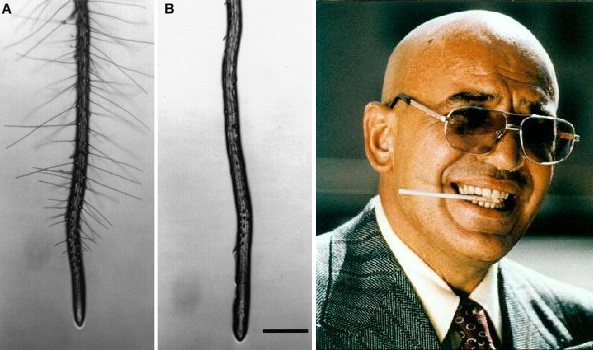
The kojak mutant (B) is completely bald! Image credit: Favery et al., 2001 and Universal Television
@JoseSci I like TIME FOR COFFEE
— Anne (@Ilovelychees) April 1, 2016
Ah yes, we can partially blame GPC’s Ruth Bastow for this one as she was co-first author on the discovery paper! TIMING OF CAB EXPRESSION1 (TOC1) had been shown to be involved in the circadian clock, and when Ruth and her colleagues discovered a gene that appeared to regulate TOC1, they named it TIC for the clever TIC-TOC of the circadian clock, then fit the full name (TIME FOR COFFEE) around it! The official reason was, “We located TIC function to the mid to late subjective night, a phase at which any human activity often requires coffee”. Hmm!
@JoseSci @GlobalPlantGPC In the stomatal lineage pathway: TOO MANY MOUTHS, YODA, SPEECHLESS. — Nature Plants (@NaturePlants) April 1, 2016
My thesis is on stomatal development, so these are close to my heart! The word ‘stoma’ is ancient Greek for ‘mouth’, so lots of stomata genes are mouth-based puns!
Where does YODA fit into this, you ask? This gene is the (Jedi) master regulator of stomatal development, of course!

The too many mouths mutant produces too many stomata. Image credit: Guseman et al., 2010.
@JoseSci @NikoGeldner SCHENGEN is my favourite!https://t.co/kSPlJo1b9O
— Christopher Grefen (@PlantesTrouveur) April 1, 2016
In the run-up to the Brexit referendum on the United Kingdom leaving the European Union, SCHENGEN is a topical choice! This gene is involved in establishing the Casparian Strip, a lignified type of cell wall located in the endodermis. The schengen mutants don’t form this barrier, so were named after the Schengen Agreement that ‘established a borderless area between European member states’.
Here’s a couple for you @JoseSci @GlobalPlantGPC: PENNYWISE, apparently named after the punk band, & POUND-FOOLISH! https://t.co/YqwULF9Iid — Lisa Martin (@lisaamartin1) April 5, 2016
Lisa’s spot on with these. The pennywise mutation was discovered first, named after a band, then when a paralogous gene was identified by the same authors, they continued the finance theme with POUND-FOOLISH.
@IHStreet @JoseSci well we are very fond of the ‘dillos (ARABIDILLO, PHYSCODILLO, etc) in my lab but we are biased…. — Juliet Coates (@JulietCCoates) April 6, 2016
The armadillo mutant in Drosophila has abnormal segment development, which looks a little like the armor plating of an armadillo. This protein contains ‘Armadillo repeats’, which is actually found in a huge variety of species including plants. The ARABIDILLO genes in Arabidopsis promote lateral root development, while PHYSCODILLO genes affect early development in the moss Physcomitrella patens.
.@JoseSci Not meant to be funny, but ARFs, because of their onomatopoetic nature are funny. — Ian Street (@IHStreet) April 5, 2016
.@JoseSci And for similar reasons: ARRs! Pirate sounds are always funny. — Ian Street (@IHStreet) April 5, 2016
Thanks, Ian!
Thanks to everyone who participated in this list. If you have a favorite whimsical gene name that hasn’t been mentioned, let us know in the comment section!
Throughout my PhD, I often found myself explaining why plants are fascinating, justifying why I was devoting four years of my life to researching the minute details of their biology.
A few weeks ago, I thought I’d ask the #plantsci community on Twitter what makes them love plants. The response was phenomenal, so I thought I’d share it here as a fun way to transition to 2017!
(This is just a handful of the huge number of comments. To read them all, click here.)
Hey #plantsci, I need your help! What makes you love plants? What’s your comeback to “plants are boring”? Thanks! Plz RT! @PlantTeaching 😉
— Sarah Jose (@JoseSci) November 9, 2016
Many of us are amazed by the fact that they can fend for themselves, rather than running away from harsh conditions or predators:
@JoseSci @PlantTeaching Plants have to deal with many of the same struggles as animals – and they can’t even run away. — Alice Foxall (@alicefoxall) November 13, 2016
@JoseSci @PlantTeaching They’re incredibly resilient and adaptive all without having a nervous system or being able to move!
— Silvia Caldararu (@SCaldararu) November 10, 2016
@JoseSci @DJPMoore Plants survive and thrive in places most humans would never dare even to visit. — Tom Buckley (@TomBuckleyLab) November 10, 2016
@JoseSci forever plastic and survive in the situation wherever they lay their roots. Not denying that’s cool!
— Kelly (@kaatkins7) November 10, 2016
Don’t worry though, because plants can fight back:
@JoseSci @PlantTeaching my tree was attacked by aphids. It released a sweet liquid that attracted ants, chasing away the aphids! — Allen Greeley (@taku2473allen) November 9, 2016
They can alter their environments in really interesting ways too:
@JoseSci @SCIHorticulture @PlantTeaching exudates – active modification of rhizosphere to block toxins entering roots and mobilise nutrients
— Mark Nason (@Cornwall_SciEnv) November 9, 2016
A lot of people are interested in plant reproduction:
@JoseSci @PlantTeaching #Plant sex lives (reproductive life cycles) are so much more complex than ours. Animal life cycles are boring. — Eve Emshwiller (@EveEmshwiller) November 10, 2016
@JoseSci @Botanical_ @PlantTeaching look at all of those reproductive strategies. Plants are truly amazing!
— The Morris Lab @MTSU (@themorrislab) November 9, 2016
Some species can survive for millennia:
@JoseSci @PlantTeaching even relatively short lived yes love longer than humans… some trees count in centuries — Dave Moore (@DJPMoore) November 9, 2016
@JoseSci @PlantTeaching Try cutting one of your appendages off and see if it regrowth like a plant can.
— Edith L. Hardcastle (@elhardcast) November 9, 2016
@JoseSci @PlantTeaching some genetic individuals (plants) might live forever — Dave Moore (@DJPMoore) November 9, 2016
Much of the rest of the ecosystem relies on them…
@JoseSci @DJPMoore Plants can live without us, but we can’t live without them. Animals are just parasites on a biosphere fueled by plants.
— Tom Buckley (@TomBuckleyLab) November 10, 2016
@JoseSci @PlantTeaching if animals died out many plants would survive…if plants died out most animals would die also — Dave Moore (@DJPMoore) November 9, 2016
… and of course, they give us much of what we need to survive…
@JoseSci @PlantTeaching bread, beer, wine, oxygen…
— Matthew Gilliham (@IonPlants) November 10, 2016
@MMLewandowski52 @PlantTeaching @JoseSci literally food out of (thin) air…especially in aeroponic systems — Krishna Udaiwal (@Plant_Learner) November 10, 2016
@JoseSci @PlantTeaching Plants do everything we do + capture sun E + synthesize virtually all useful medicines and poisons + are beautiful
— Paul Twigg (@UNKBiol106) November 9, 2016
@JoseSci @PlantTeaching Kinda hard to breathe without ’em, for one! — Dan Lin (@DLinYZ) November 10, 2016
@JoseSci @PlantTeaching Well, they make colours, flavours, fragrances, drugs…
— Anne Osbourn (@AnneOsbourn1) November 10, 2016
@JoseSci @PlantTeaching we depend on plants for just about everything, plants are _not_ boring! — McPanos (@panagopucakes) November 18, 2016
We need to highlight how amazing plants are, to counteract “plant blindness”:
@JoseSci @PlantTeaching read this amazing article about #plantblindness by @fossilplants https://t.co/xYWS0MATGM — Lyza Maron (@LyzaMaron) November 10, 2016
@JoseSci @Botanical_ @PlantTeaching plants are all around, always. We watch them seldom. The beauty of the unseen — SEB (@SEBriologia) November 9, 2016
Plant blindness means that many people are unaware of the amazing things that are happening around them:
@JoseSci @PlantTeaching 1) only boring on a minute-by-minute timescale – sped-up timelapses reveal remarkable behaviour (eg phototropism) — Daniel Seaton (@DanielDSeaton) November 11, 2016
@JoseSci @PlantTeaching plants are more just more veiled about how cool they are…like the quiet kid w/ some WILD tricks up their sleeve
— Beth Ansaldi (@AWomaninSTEM) November 9, 2016
Being scientists, a lot of people liked how easy plants are to work with!
@JoseSci @PlantTeaching Plants stay in one place, so I can sample them easily. I love them for that! — A.C. Papageorgiou (@ACPapageorgiou) November 10, 2016
@JoseSci @PlantTeaching It is not as much paperwork when you want to dissects plants! And their stem cells make Sequoia trees live (almost) forever ! — Marie Pireyre (@MapiMry) November 10, 2016
@JoseSci @PlantTeaching They stand still while I measure them! — Vigdis Vandvik (@VVandvik) November 10, 2016
Some of the biggest scientific discoveries were made in plants:
@JoseSci @PlantTeaching the big discoveries. Mendel & the pea; Hook & first cell; McClintock & transposable elements; PTGS in petunia
— Peter Etchells (@peter_etchells) November 9, 2016
In conclusion:
.@JoseSci @JohnInnesCentre @PlantTeaching
Plants are awesome!
— Molecular Plant Path (@MPPjournal) November 11, 2016
Thanks to everyone who took part in this twitter chat! This is just a subset of the huge number of comments we received. To read them all, click here!
Have we missed anything? Why do you love plants?

Here at the GPC we love social media. It provides a fantastic platform upon which we can spread awareness about our organisation and the work we do. Since Lisa Martin’s appointment as Outreach and Communications Manager in February of this year, and the New Media Fellows two months later, we have expanded our online presence and are reaching more people than ever before. We still have a way to go, but here are a few things we’ve learnt over the past year that might provide you with a bit more social media know-how.
To increase your following as an individual try to produce maybe one or two good tweets everyday. If you’re tweeting on behalf of an organization and have more time or people power, 5–8 tweets a day should be your target.
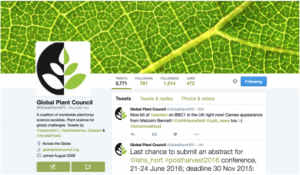
The Global Plant Council twitter account now has over 1500 followers. Find us @GlobalPlantGPC
Our Twitter following has grown rapidly over the past year. We had 294 followers on Twitter in September 2014 and now have over 1500! Much of this has been down to there now being four of us maintaining the account rather than Ruth Bastow (@PlantScience) on her own.
The more you tweet, and the better you tweet, the more followers you will get. Things move fast in the Twittersphere, so just a few days of inactivity can mean you drop off the radar.
For more hints about using Twitter see this great article from Mary Williams (@PlantTeaching): Conference Tweeting for Plant Scientists Part 1 and Part 2.
Decide on who you want to connect with, find out which social media platform they se most, and set yourself up!
As a global organization we want to connect with all our members and plant scientists around the world, so we need to use different means of communication to do this. In April 2015 we set up a Spanish language Twitter account with Juan Diego Santillana Ortiz (@yjdso), an Ecuadorian-born PhD student at Heinrich-Heine University in Dusseldorf, Germany, who translates our tweets into Spanish.
Of course Twitter is not universally popular, and our main following seems to come from the
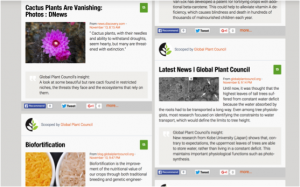
The newest edition to the GPC social media family is our GPC Scoop.It account which you can find here
UK and US. To connect with those choosing to use different communication platforms, New Media Fellow Sarah Jose set up a GPC Scoop.It account in September 2015. Around this time we also set up a GPC Facebook page after many of our member organizations told us this was their primary means of connecting with their communities. Although relatively new, this page is slowly gaining momentum and we hope it will provide a great outlet for conversation in the future. Find out about which of our member organizations are on Facebook here.
If there’s a site you use to stay up to date with science content that we don’t have a presence on, do let us know and we will look into setting up an account!
Ultimately, the best way to expand your reach online is to generate your own content.
The GPC blog was started in October 2014, and in its first 14 months of life received an average of 142 views per month. However, since Lisa, myself and Sarah started working with the GPC, we have been generating one blog post every week, with the result of our monthly views shooting up to almost 700 views per month since May.
This just shows that generating interesting and regular content really does work in terms of increasing reach and online presence. All these blog posts have also contributed towards a growing following on our various social media sites over the past six months.
If you want to write for us, please send us an email or get in touch on Twitter! We are always looking for contributions from the plant science community. Perhaps you’ve recently attended a scientific meeting, are doing a really cool piece of research, organized a great outreach activity or have seen something relevant in the news. Whatever it is, we want to know.
We’re also happy to write about the GPC for your blog or website, so if you would like us to contribute an article, please get in touch!
Try to have a global presence across as many platforms as you think you can maintain, although an inactive account on any social media site won’t do you any favors, so don’t take on too much!
I’ve already described our presence on Twitter, Facebook, Scoop.It and the blog, all of which help make our organization accessible, however people want to use social media.
In addition to this we of course have the GPC website, and Lisa sends out a monthly e-Bulletin providing a summary of all the information published on the website for that month. Anyone can sign up here to stay up to date with our activities, and it’s free!
In a bid to further reach out to members that perhaps don’t engage with social media (yet!), Lisa wrote this article explaining what the GPC does and sent it out to be published by our various member organizations.
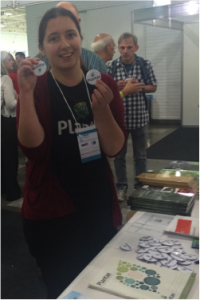
New Media Fellow Sarah Jose promotes our new Plantae platform at IPMB 2015
Confession time, this isn’t really a helpful hint on how to use social media, but Plantae is so good it deserves a section all on its own!
We are hoping Plantae, set up by the GPC in collaboration with the ASPB, and with support from the SEB, will be the digital ecosystem for the plant science community. It will provide a platform for plant scientists to collaborate with one another, network, and access journals, advice and jobs. You can read more about Plantae on our blog, here.
It’s now in beta testing and you can sign up to give it a go at http://www.plantae.org. Let us know what you think!
 – we’re even helping to develop a new social media platform just for plant scientists! As well as this blog, we also have two Twitter accounts: our main, English-language account is at @GlobalPlantGPC, to which myself (@lisaamartin1), Ruth (@plantscience), and GPC New Media Fellows Amelia (@AmeliaFrizell) and Sarah (@josesci) all contribute. Alternatively, if you speak Spanish we also have a Spanish-language account at @GPC_EnEspanol (operated by Ecuadorian-PhD-student-in-Germany Juan-Diego Santillana-Ortiz; @yjdso, who kindly translates our tweets).
– we’re even helping to develop a new social media platform just for plant scientists! As well as this blog, we also have two Twitter accounts: our main, English-language account is at @GlobalPlantGPC, to which myself (@lisaamartin1), Ruth (@plantscience), and GPC New Media Fellows Amelia (@AmeliaFrizell) and Sarah (@josesci) all contribute. Alternatively, if you speak Spanish we also have a Spanish-language account at @GPC_EnEspanol (operated by Ecuadorian-PhD-student-in-Germany Juan-Diego Santillana-Ortiz; @yjdso, who kindly translates our tweets).
We find Twitter a great way to share links, news, journal articles and conference updates, while also networking with the global plant science community. Join over 1000 other plant scientists and enthusiasts and follow us, if you’re not already!
If you’re not sure where to start with Twitter, Mary Williams from ASPB (@PlantTeaching) has written a great two-part blog (we feature in Part 1! And here’s Part 2) that will help you get started and understand the ‘twetiquette’ of tweeting, especially from conferences.
Although Facebook is by far the most popular social networking site across the globe, the way we use it has evolved dramatically since its inception in 2004. ‘Thefacebook’ as it was first known, was famously founded by Harvard University student Mark Zuckerberg as a way for his fellow students to view and comment on photographs of their dorm-mates. Initially restricted to Harvard, the website soon expanded to universities across the US, then the world, and now almost anyone can use it, even without an academic email address.
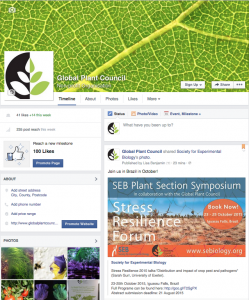 But Facebook has moved on from its early days and it’s now not all about ‘poking’ your friends (remember that?!). Now worth billions of dollars, Facebook has morphed into an all-encompassing platform for both recreation and business. While many people still use Facebook to keep in touch with friends and family, share photos and status updates, it’s also increasingly being used to share news, articles and opinions, to play games, form groups or communities, and as a tool for companies and organizations to interact with and advertise to customers or members.
But Facebook has moved on from its early days and it’s now not all about ‘poking’ your friends (remember that?!). Now worth billions of dollars, Facebook has morphed into an all-encompassing platform for both recreation and business. While many people still use Facebook to keep in touch with friends and family, share photos and status updates, it’s also increasingly being used to share news, articles and opinions, to play games, form groups or communities, and as a tool for companies and organizations to interact with and advertise to customers or members.
At the Society for Experimental Biology conference in Prague in June, I heard several scientists extolling the benefits of social media, particularly – and perhaps unsurprisingly – in the Education and Outreach sessions. I was particularly interested to repeatedly hear the message that Facebook is a very useful tool for science communication and outreach – so we’ve decided to try it!
Having only ever used Facebook for personal uses, Sarah and I asked some prolific social media users for their advice on starting and using a Facebook page, and in answer to the question, “Why should we bother with Facebook?”, the overwhelming message was clear: Facebook is used by more, different people.
Compared to Twitter, which has around 316 million users, Facebook reached its 1 billionth account in 2012, and while the people we spoke to find that most of their Twitter followers are from English-speaking countries, their Facebook visitors represent a much broader range of geographic locations and languages. Furthermore, unlike setting up and maintaining a website, it’s free to set up Facebook pages or groups, so some organizations only exist on social media. By setting up a Facebook page for the GPC, we should, in theory, be able to interact with more people than we would with just our Twitter accounts and blog, thus we will be able to share and promote plant science all over the world more effectively and to a greater diversity of people.
If you’re attending our SEB Plant Section Symposium on Stress Resilience, you can also let us know by joining our Facebook event! (Please note however, that saying you’re coming to the meeting on Facebook is not the same as registering! You’ll need to do that here.)
Here’s a list of some of our Member Organizations who also have a presence on Facebook. Let us know if there are any other pages we should ‘like’! We’re also interested to hear from you if you have any thoughts about using social media, or suggestions of content you would like to see on Facebook. How do you use Twitter and Facebook, and how does your use of these channels differ, if at all? Please comment below!
 This week we spoke to Mary Williams about plant science education, her role as features editor of The Plant Cell, and effective use of social media for scientists.
This week we spoke to Mary Williams about plant science education, her role as features editor of The Plant Cell, and effective use of social media for scientists.
What inspired you to focus your career on education in the plant sciences?
As a biochemistry student whose friends were arts majors, I discovered that I really enjoyed the challenge of explaining things through plain language and analogy. After a postdoc I took a faculty position at a primarily undergraduate institution where professors were encouraged to explore different approaches to teaching.
By sharing ideas and resources through ASPB Teaching Tools in Plant Biology, workshops, and my blog, I try to help young scientists gain confidence and become better teachers.
How have people responded to the Teaching Tools in Plant Biology (TTPB) you have developed, and how are these being used?
The response has been really positive. I regularly hear from undergraduates, graduate students, postdocs, lab heads and educators who are using them for a multitude of purposes including lesson preparation, self-learning and outreach. The articles can be accessed through most university libraries or via ASPB membership. They are also available throughout the developing world through the AGORA program.
The teaching tools articles are quite technical, so we didn’t anticipate that high school teachers would want to read them. However, in response to their expressed interest I started posting interesting newsclips and videos onto the various social media sites that I manage. This summer we’re moving all of the content onto a new platform, Plantae.org, which will provide a centralized place for educators to connect in what I have described as a Global Plant Science Learning Community. I’m really excited about providing a space for people to share their ideas and promote discussions about effective plant science teaching.
Why do you think teaching the plant sciences in an inspirational way proves so difficult?
The biggest obstacle is the preconception that plants are not interesting, which too often is conveyed by teachers in primary and secondary education. Additionally, many students have no first-hand experience of growing or caring for a plant, and this first-hand experience is really key. We find that many of the most engaged young people have grown up in close contact with plants, perhaps through a family’s involvement in agriculture or horticulture.
In terms of status and salaries, our society places a much higher value on medical sciences and medical research than the plant sciences; the tangible rewards of working with and studying plants are not always evident.
How can we better capture student imaginations when it comes to plants?
Giving students the opportunity to physically engage and inquire about plants is critical, and this has to span from the earliest years through university education. Students need to use all of their senses when exploring plants, and being allowed to explore in an open-ended way lets students develop an interest and curiosity about plants.
This idea of exploration and open-ended inquiry should continue into university, even in large lecture classes. Give students a pea in a pot to take home and observe. Hand out Brussels sprouts, green onions and daisies for students to pull apart and examine. Use some class time to pose open-ended questions. Good ideas are plentiful!
Innovative tools and support for teachers can also be found on sites such as Wisconsin Fast Plants developed by Paul Williams, SAPS and PlantingScience.org.
You are features editor for The Plant Cell. What does this role involve?
TTPB is published by The Plant Cell, and we made the decision early on to focus our effort on the teaching of upper-level plant biology. This is the point at which students transition from using textbooks to the primary literature.
To write each article, I read dozens of recent papers and review articles to identify the key questions and the foundational concepts a student needs. I then create both a written article and an image-rich version of the information. Images are powerful ways to explain difficult concepts, and also are useful to people who teach and learn in languages other than English. After I finish the articles I send them out to several experts for peer review. I update the articles regularly so that they continue to reflect our current understanding.
A new initiative this year has been to draw on the talents of the community to develop additional Teaching Tools topics. We’ve been running competitions to solicit pre-proposals for development into Teaching Tools – you can read more about that here.
When did you first get involved with social media? How can social media platforms such as blogging and Twitter be of benefit to researchers?
My social media roots stretch back to the early 1990s when I was active in the usenet email-based Arabidopsis and Plant Education newsgroups. These networks were excellent sources of resources, ideas and support as I became an independent researcher and educator.
I started using Twitter, ScoopIt and Facebook in earnest in 2011 with the encouragement of Sarah Blackford (@BiosciCareers) and the Global Plant Council’s Ruth Bastow (@plantscience). Like many people, I quickly realized the power of Twitter and other social media tools as a way to connect and converse with the broader community of plant scientists, plant educators, and other plant enthusiasts. Social media not only lets me meet and learn from plant scientists from around the world, but also keep abreast of new publications and get a glimpse into what is being discussed at conferences.
Mary’s top tips for getting started on social media:
Meet Amelia and Sarah, the two newest additions to the Global Plant Council team.
As a coalition of plant and crop societies from the around the globe, the Global Plant Council (GPC) aims to bring together scientists, policy makers and other stakeholders to engage in coordinated strategies to find solutions to global problems.
The GPC currently has 29 member organizations representing thousands of scientists in diverse disciplines around the world. Online media such as this blog and the @GlobalPlantGPC Twitter account provide a fantastic resource for our member organizations to stay in touch, share ideas and develop interdisciplinary collaborations.
For Spanish speakers, we’ve also recently launched a Spanish version of our Twitter feed at @GPC_EnEspanol, kindly translated for us by Juan-Diego Santillana-Ortiz, an Ecuadorian currently studying at Heinrich-Heine University in Düsseldorf, Germany.

Amelia Frizell-Armitage is in the third year of her PhD at the John Innes Centre, Norwich UK. She is researching how altering the biochemistry of epicuticular waxes affects the physiology and ultimately yield of UK wheat. She tweets @AmeliaFrizell.
To further enhance this network, the GPC has awarded two New Media Fellowships to early career plant scientists Amelia Frizell-Armitage and Sarah Jose. The role of the Fellows will be to increase visibility of the GPC through managing this blog, devising new strategies to promote GPC activities and to increase traffic flow and engagement on Twitter.
A key priority will be to increase members’ contributions to this blog to promote their organizations and associated activities. Contributing to the blog is a fantastic way to interact with other GPC members, and we are always open to suggestions for guest posts. Perhaps you want to talk about a recent meeting or activity, discuss a particularly exciting piece of emerging research, promote a newly published book, or even just give some insight into your everyday life?

Sarah Jose is a third year PhD student at the University of Bristol, UK. She is investigating the link between wax biosynthesis and stomatal development in barley and Arabidopsis, and its potential impact on the water use efficiency of plants. Find her on Twitter @JoseSci.
Whatever it is, we want to hear from you! Please get in touch on Twitter, via the comments section on the blog, or by emailing our Outreach & Communications Manager Lisa Martin.
It is an exciting year ahead for the GPC with the launch of a new online platform for the plant community that is being built in partnership with the ASPB and with support from SEB. There are also various fundraising initiatives in the works, and a Stress Resilience Forum coming up in October, which is being organized in collaboration with SEB.
Stay tuned to this blog to keep up to date with all our activities. The events calendar for member organizations is also looking busy and vibrant, and can be found here.